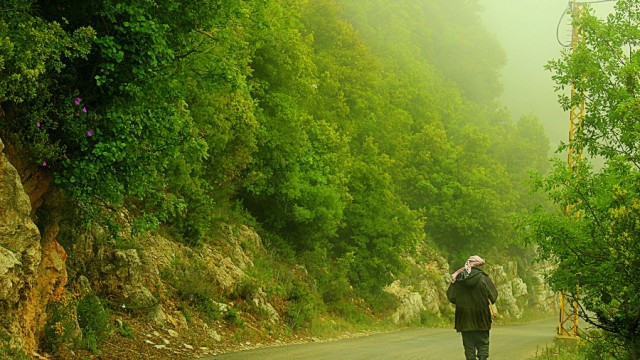|

|
Length
|
12km (5-6hrs)
|
Uphill
|
200 m cumulative
|
Evaluation
|
Average
|
|
 |
|
Start at St. George chapel of Bkarta, altitude 1300m.
From the old oak tree next to the eastern wall of the chapel, a narrow footpath goes East, up to nearby Ain Bkarta, a captured water spring, and continues North, uphill to Aarbet Marina where it turns westwards to cross the width of the thalweg above the chapel to an old sand quarry to the right.
Pass over the quarry, altitude 1400m (culminating point of the itinerary), then downhill to the apple orchards of “Sar an-Nahl”. The sandy road that goes along is one option to continue to Jaj. Turn left to the greenfields of Ram Mechmech plateau, then right to the pass where old houses and sheepfolds are well hidden among trees and rocks. Go downhill to Jaj by the nice footpath of the large “Roueimat” valley and the rocky crest in its middle.
|
 |
|
Well worth a pause is the spring-well and the old “qabou” shelter dominating the area. Arriving to the “Marj” prairie, a short uphill leads to the asphalt of the “Ansil” quarter of Jaj and to the tiny bridge spanning the “Mazrouq” stream, 1200m.
|
|
 |
|
Take the uphill side street and left to a fountain after which a concrete path to the left leads to one of the most beautiful oak trees you’ve ever seen, next to Mar Abda parish church, also worth a visit. The main street is 50m away. Cross it to continue uphill along an internal street until it reaches its apex, 1300m, at a belvedere-like point before turning right to a sculptor’s workshop, with art works scattered around. A jeep track starts here, to the right for a downhill way through the “Msita” orchards and wooded slopes until the renovated Mar Challita monastery better known as Deir al-Qattara.
|
|

|
|
Above the lintel, a plaque in Syriac commemorates its founding. An asphalted road leads to Qattara small village and to the medieval patriarchal residence of “Saydet Ilige”, the very purpose of this trail.
Only part of the asphalt can now be avoided without much pain. Just under the monastery, a nice water spring, Ain Ram, is a good place for picnic. A footpath goes along the left flank of the small valley below, passing olive orchards and exits at the asphalt that again can be short-circuited between two turns.
|
|

|
|
One last 100m of road and the Ilige chapel appears. A roman temple, transformed into a church, residence of patriarchs for 250 years, long before Qannoubine.
One could terminate here but an interesting place lays ahead: Some 20-minute walk, mostly on footpaths, through the traditional houses of Qattara, an old watermill, a bridge and “Ain al-Baidar” water spring to finally reach the large monastery of “Saydet an-Najat” in Mayfouq village, 870m.
Besides the arched cloister and the vaulted church, a special place is kept for “Our Lady of Ilige”, a very old painting of Virgin Mary, found under 10 other layers that had covered it during the ages. It was discovered while being restored in the Vatican.
|
|
|
CONTINUATION FOR T12
|
Length
|
12km (6hrs)
|
Uphill
|
400 m cumulative
|
Evaluation
|
Average+
|
|
 |
|
From al-Ansil bridge, a path continues North to al-Blat, another quarter of the village, where the road to the Cedars of Jaj passes. Cut the asphalt to a footpath following a stream; if too much water, there is an alternative route. The trail goes up to an old ruin and continues to the saddle-like path separating Jaj from Tartej.
Downhill to “Ain al-Fasline” spring where the road is cut to continue by footpath to a stone sawmill, at one edge of the village of Tartej, 1100m. One needs to cross it to the other extremity, either following the major axis or, preferably, the internal roads both passing the old oak tree and old Saint George chapel before arriving to the foot of “al-Aqbeh”, that is the steep slope. One of the nicest pebble footpaths awaits the hiker. A steep uphill it is, along “Wadiaj-Jnaynet” to the pass separating Tartej from Douma, 1350m.
|
|

|
|
The last stretch is a downhill, partly on a narrow footpath, partly on what is left of what looks like a “roman highway”, a large pebbled footpath of past glory.
Again a very old oak by the temple-chapel of Mar Nohra and the famous fountain of “Ain ‘Okfor”. We’re now in Douma. More downhill via side roads and you’re at the central place, at the entrance of the old preserved souks. A sarcophagus with a greek inscription is your sign that this is the end of the trail, 1050m. Douma is worth the visit. Nice traditional houses, red-tiled in majority, give it a special cachet.
|
|
|

